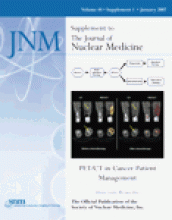Abstract
Early detection of recurrence is clinically important and can improve the prognosis and survival of patients with cancer. CT, considered the primary method of investigation because of its low cost and widespread availability, provides high-resolution anatomic details but may underestimate the actual tumor burden by overlooking small tumor clusters in areas of distorted anatomy after treatment. 18F-FDG PET is an effective whole-body imaging technique that detects metabolic changes preceding structural findings. However, the specificity of PET is impaired by false-positive or equivocal results attributable to the lack of precise anatomic landmarks and to sites of increased 18F-FDG uptake of nonmalignant etiology. PET/CT provides fused images that demonstrate the complementary roles of functional and anatomic assessments in the diagnosis of cancer recurrence through the precise localization of suspected 18F-FDG foci and their characterization as malignant or benign. In addition to the accurate diagnosis and definition of the whole extent of recurrent cancer, PET/CT has an impact on patient management because it can assist in defining potential candidates for surgery for cure, planning the appropriate surgical or radiotherapy approach, and referring patients with unresectable disease to other therapeutic options.
Footnotes
-
COPYRIGHT © 2006 by the Society of Nuclear Medicine, Inc.







